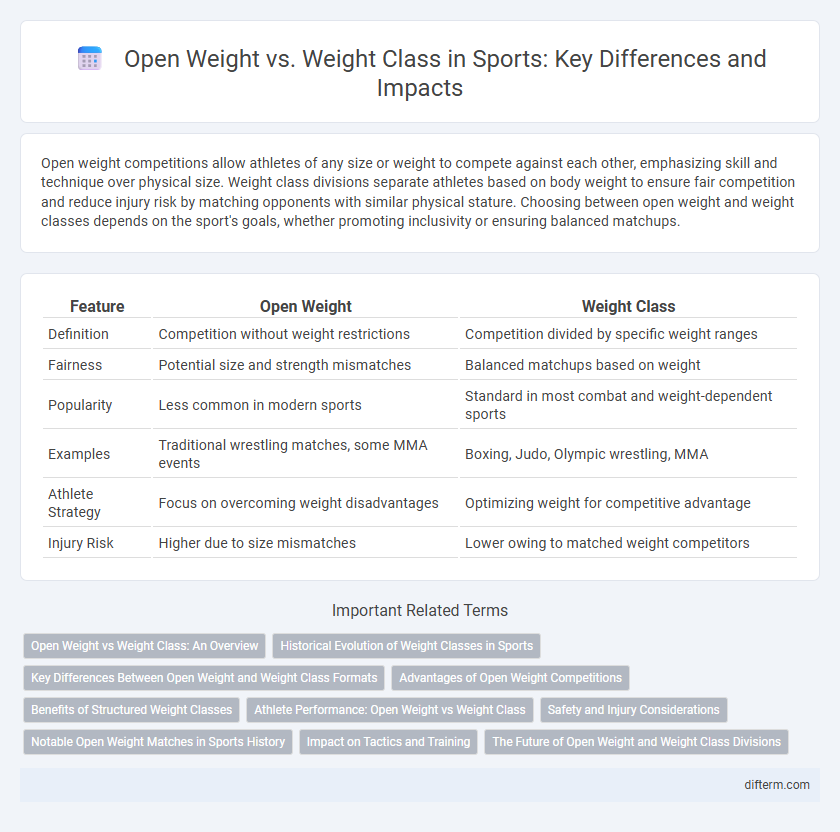Open weight competitions allow athletes of any size or weight to compete against each other, emphasizing skill and technique over physical size. Weight class divisions separate athletes based on body weight to ensure fair competition and reduce injury risk by matching opponents with similar physical stature. Choosing between open weight and weight classes depends on the sport's goals, whether promoting inclusivity or ensuring balanced matchups.
Table of Comparison
| Feature | Open Weight | Weight Class |
|---|---|---|
| Definition | Competition without weight restrictions | Competition divided by specific weight ranges |
| Fairness | Potential size and strength mismatches | Balanced matchups based on weight |
| Popularity | Less common in modern sports | Standard in most combat and weight-dependent sports |
| Examples | Traditional wrestling matches, some MMA events | Boxing, Judo, Olympic wrestling, MMA |
| Athlete Strategy | Focus on overcoming weight disadvantages | Optimizing weight for competitive advantage |
| Injury Risk | Higher due to size mismatches | Lower owing to matched weight competitors |
Open Weight vs Weight Class: An Overview
Open weight competitions showcase athletes competing without weight restrictions, emphasizing skill and technique across diverse body types, while weight class divisions segment competitors by weight to ensure fairness and balanced matchups. In sports like wrestling, judo, and mixed martial arts, weight classes minimize physical disparities, reducing injury risk and emphasizing strategy within similar body masses. Open weight contests challenge athletes to adapt tactics against often larger or smaller opponents, highlighting versatility and broad athletic ability.
Historical Evolution of Weight Classes in Sports
Weight classes in sports evolved to promote fairness by ensuring competitors faced opponents of similar body mass, a practice originating in boxing during the 19th century. The implementation of distinct weight divisions quickly spread to wrestling, mixed martial arts, and weightlifting, standardizing competition and enhancing athlete safety. Open weight categories, existing alongside weight classes, remained popular for showcasing exceptional skill irrespective of size, though modern sports organizations increasingly emphasize weight classes to optimize fairness and performance equity.
Key Differences Between Open Weight and Weight Class Formats
Open weight competitions allow athletes of any body mass to compete against each other, emphasizing overall skill and technique regardless of size. Weight class formats categorize competitors into divisions based on their body weight, aiming to ensure fairness and safety by matching athletes with similar physical characteristics. This structural difference impacts strategies, training approaches, and competition dynamics, with weight classes promoting balanced matches and open weight contests testing adaptability across diverse physiques.
Advantages of Open Weight Competitions
Open weight competitions allow athletes of varying sizes and strengths to compete directly, showcasing pure skill, technique, and strategy without weight restrictions. This format fosters unpredictability and dramatic matchups, enhancing spectator excitement and broadening the competitive landscape. Open weight events also encourage fighters to adapt quickly to diverse opponents, promoting versatile athletic development.
Benefits of Structured Weight Classes
Structured weight classes promote fair competition by matching athletes with similar body masses, reducing injury risks associated with mismatched sizes. They ensure skill and strategy are prioritized over sheer physical dominance, enhancing the quality of sports like boxing, wrestling, and mixed martial arts. Weight classes also provide clear pathways for athlete development and record-keeping, fostering organized progression and recognition in competitive sports.
Athlete Performance: Open Weight vs Weight Class
Athlete performance in open weight competitions often challenges competitors to adapt strategies against diverse body sizes and strengths, emphasizing versatility and technique over sheer power. Weight class divisions, by contrast, allow athletes to compete against others with similar body mass, enabling more precise conditioning and optimized power-to-weight ratios for enhanced speed and endurance. Research indicates that performance metrics in weight-class sports display greater consistency, while open weight events tend to highlight exceptional skill disparities that can influence outcomes.
Safety and Injury Considerations
Open weight competitions pose higher risks of injury due to mismatched size and strength differences among athletes, increasing the potential for concussions, joint injuries, and muscle strains. Weight class divisions minimize these risks by grouping competitors with similar body mass, allowing for fairer matches and reducing the likelihood of severe trauma. Safety protocols in weight-class sports emphasize proper weight management and medical monitoring to prevent dehydration and other health complications linked to rapid weight changes.
Notable Open Weight Matches in Sports History
Notable open weight matches in sports history showcase the dramatic contests where competitors from varying sizes and weight classes face off, emphasizing skill and strategy over size advantage. Matches like Antonio Inoki vs. Muhammad Ali in 1976 and the 1983 bout between Royce Gracie and Kimo Leopoldo highlight the unpredictability and excitement inherent in open weight competitions. These encounters have shaped combat sports by challenging traditional weight class boundaries and demonstrating the potential of technique and endurance against pure size and strength.
Impact on Tactics and Training
Open weight competitions demand versatile tactics and adaptive training to handle opponents of varying sizes, emphasizing strength and endurance across all ranges. Weight class divisions allow athletes to specialize in tailored techniques and conditioning specific to their category, optimizing speed, power, and agility. Training regimens in weight-class sports often prioritize weight management and precision skill development to maximize competitive advantage.
The Future of Open Weight and Weight Class Divisions
Open weight divisions allow athletes of varying sizes to compete, fostering unpredictable and exciting matchups, while weight class divisions promote fairness by matching competitors of similar size and strength. Emerging trends in combat sports suggest a growing emphasis on hybrid formats combining elements of both, aiming to balance competition equity with spectator appeal. Advances in athlete conditioning and performance analytics are likely to drive further evolution of these divisions, optimizing both safety and competitive integrity.
open weight vs weight class Infographic

 difterm.com
difterm.com